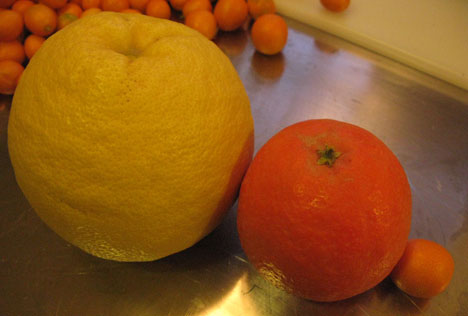
Nagami Kumquat (Flickr/miheco)
For some reason, it was only recently that I first tasted a kumquat. I always assumed they were too tart for my taste. And, you know what happens when you assume, don’t you? The kumquat, of which there are four different varieties and only one that I’ll discuss – the Nagami, for it’s superior flavor – thrives here in Tucson. The rind is sweet and the center is only mildly tart. You eat the whole thing – peel and all.
The Nagami kumquat came to London from China in 1846 by Robert Fortune, sealing its fate into the genus Fortunella rather than Citrus, though it is often included in the genus Citrus. The fruit was officially brought to the U.S. from Japan in 1885, though reports of kumquats in North America date as far back as 1850.
Recently, I had the pleasure of helping harvest an abundant amount of citrus from someone’s land. Although we harvested some amazing, tasty and attractive tangelos, navel oranges, Meyer lemons, pink lemons, and grapefruit, I was drawn to the immense tree of Nagami kumquats. Reports on the internet peg mature tree anywhere from 8 – 15 feet. The tree that we harvested had to be at least 15 feet tall, and perhaps taller. It was loaded with fruit. After filling an entire crate and half of a paper grocery bag the tree barely looked touched.
If you’re interested in checking out the Nagami kumquat and can’t find any in the stores – they’re quite seasonal – give a call or a visit to Mesquite Valley Growers. It’s 23 acres of every kind of plant, tree, and shrub you might ever want to grow in Tucson as well as every varietal of fruit that does well in Tucson: apricots, blueberries, blackberries, figs, peaches, and every kind of citrus you can imagine – including kumquats. Most of the citrus trees have fruit on them, so you can try them right there in the greenhouse. And kumquats do great in containers.
Let me know if you go.
